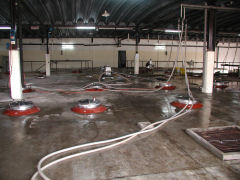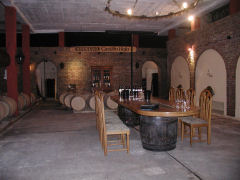 Las Piedras – Thursday afternoon found us sated from our veal and potato lunch and semi-dozing in the van as we headed for our next stop, Castillo Viejo outside the town of Las Piedras in the province of San Juan. This is another big operation, with about 325 acres of vines planted, and producing slightly over 1 million liters of wine, half of it bulk table wine, half of it fine wine (of which 75% is exported to 20 different countries). Note the start of the processing – a large garage like room with stainless steel tanks underground, and machinery that handles all the pressing and crushing and then wine is pumped into the various and numerous tanks via a very organized, computerized system, something necessary given the volume of production. Founded in 1927 it is still a family run operation – in fact, I learned, that with the exception of one winery in the country, all of the 280-ish wineries in Uruguay are owned and operated by individual families.
Las Piedras – Thursday afternoon found us sated from our veal and potato lunch and semi-dozing in the van as we headed for our next stop, Castillo Viejo outside the town of Las Piedras in the province of San Juan. This is another big operation, with about 325 acres of vines planted, and producing slightly over 1 million liters of wine, half of it bulk table wine, half of it fine wine (of which 75% is exported to 20 different countries). Note the start of the processing – a large garage like room with stainless steel tanks underground, and machinery that handles all the pressing and crushing and then wine is pumped into the various and numerous tanks via a very organized, computerized system, something necessary given the volume of production. Founded in 1927 it is still a family run operation – in fact, I learned, that with the exception of one winery in the country, all of the 280-ish wineries in Uruguay are owned and operated by individual families.
 Our experience at Castillo Viejo was somewhat different than at the first three places we visited, and the two I’ve visited previously. This was the first time that we weren’t met, and guided around, by someone either from the family that owned the place, or someone directly involved in the wine-making process. Instead we had a couple of the winery’s marketing people meet with us. Although both quite nice people, the problem when a winery chooses to handle journalists (or any visitors for that matter) this way is that most of us have lots of questions, and generally about the details of the wine, and as we walk around, about various things we might notice. We are also influenced by the very style of communication offered by whomever is our guide. Owners, winemakers, and cellar-masters tend to have a deep passion for wine and for what they are doing – it’s why they do it. They are also generally well versed in the technical details and have a good handle on pretty much everything going on. Marketing people tend to have a cursory knowledge of those sorts of things, though they’re often quite good with details about sales and various figures. They also, I’ve found, rarely have a passion for wine – for them, it’s just the product they happen to be pushing. The spiel is canned. Questions outside the basics are often left unanswered, or with a clearly made up guess. In fact, the young man who was the head of marketing spent most of the time peppering me with questions about where and how to advertise their wines. You can tell the difference.
Our experience at Castillo Viejo was somewhat different than at the first three places we visited, and the two I’ve visited previously. This was the first time that we weren’t met, and guided around, by someone either from the family that owned the place, or someone directly involved in the wine-making process. Instead we had a couple of the winery’s marketing people meet with us. Although both quite nice people, the problem when a winery chooses to handle journalists (or any visitors for that matter) this way is that most of us have lots of questions, and generally about the details of the wine, and as we walk around, about various things we might notice. We are also influenced by the very style of communication offered by whomever is our guide. Owners, winemakers, and cellar-masters tend to have a deep passion for wine and for what they are doing – it’s why they do it. They are also generally well versed in the technical details and have a good handle on pretty much everything going on. Marketing people tend to have a cursory knowledge of those sorts of things, though they’re often quite good with details about sales and various figures. They also, I’ve found, rarely have a passion for wine – for them, it’s just the product they happen to be pushing. The spiel is canned. Questions outside the basics are often left unanswered, or with a clearly made up guess. In fact, the young man who was the head of marketing spent most of the time peppering me with questions about where and how to advertise their wines. You can tell the difference.
I guess the winery’s owner is so accustomed to seeing American wine writers that they see no need to meet them anymore. From your tasting notes, it seems like the communications staff may be making some of the wines.
I doubt they’re accustomed to wine writers visiting – it’s a pretty unusual thing in Uruguay and really just beginning (exportation of Uruguayan wine only began six years ago, and until about two years ago was limited to about 3-4 wineries of larger size, like this one) – after all, that was the purpose of this trip! I think the problem is just simply that this particular winery is more focused on volume business, and the “higher end” wines are new for them – not really any different than any other large winery in the world. As to the owners not being there, who knows? Maybe they thought that the marketing director, because he speaks English, was a better ambassador – that was one of the things that seemed to surprise the people at every single winery we visited, that I, a norteamericano, could actually speak Spanish. Then again, to be fair, it surprised me how many of them could actually speak English… Though, I insisted for the entire trip in operating in Spanish, it was buen practica for me to have that level of conversation in my newly acquired tongue!
Yes, Dan. Of course they do not see many American wine writers. I was using the ancient and honored art of sarcasm. Seems like you had a really nice trip, all in all. I feel like I was almost there in spirit. But I think I’d forget that steak temperature flag gizmo and continue to rely on how a steak feels as I’m cooking it.
I just want to see if I can get one or more of the bands to turn orange!